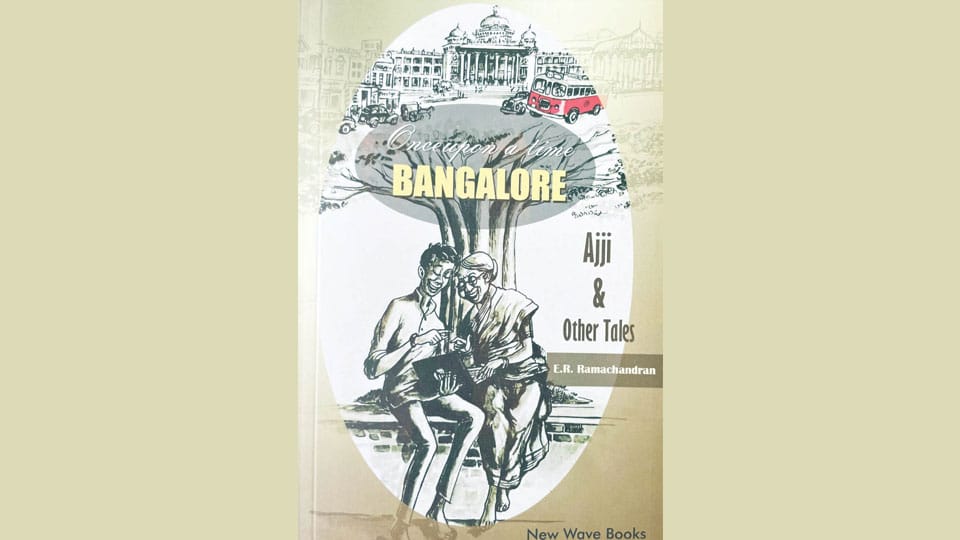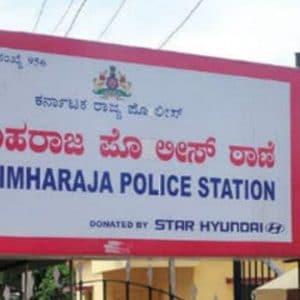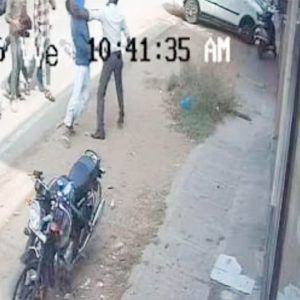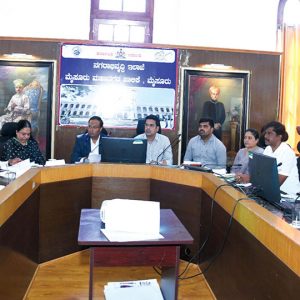By Gouri Satya
- Title: Once upon a time Bangalore: Ajji & Other Tales
- Author: E. R. Ramachandran
- Pages: 250+IV
- Price: Rs. 230
- Publisher: New Wave Books, Basavanagudi, Bangalore
To err is human, said someone who perhaps was prone to commit errors.
But to ERR, all capital letters? Is it Blunder, again with a capital B?
No way, Sir.
Here, to ERR is humour. And that is E.R. Ramachandran’s forte.” Says H.N. Ananda in his foreword to this book.
This forte of Ramachandran is seen in his latest work on Bangalore, how it was a few decades ago, before the exponential rise in infrastructure and the advent of IT industries. Ramachandran sees Bangalore through the eyes of his Ajji, his grandmother, when it was a beautiful city of pensioners and office and factory-goers in a relaxed daily routine.
Ramachandran is Ramu for his Ajji. His Ajji is both traditional and modern. An up-to-date Ajji, she is abreast of happenings all around. She goes to Harikathe or to listen to the Dhanurmasa Pravachana and chants Lalitha Sahasranama in her unique way. Her life does not stop at that. Having learned computer basics, she is an expert in WhatsApp and Facebook. Her friends are Software Seethamma and Hardware Hemalatha Bai. She takes them on an online Yatra to pilgrim places.
Aware of the latest develop-ments, she passes cryptic comments on subjects like cricket and IPL, on the ‘foolish idea’ of building a statue on the seismologically-sensitive area near the Krishna Raja Sagar (KRS) Dam, on the rights of an MP or an MLA, or about the World Bank food politics. For that matter of fact, on any subject under the sun.
Age is no bar for her. Her comments are sharp and sarcastic; her target is the ‘good for nothing’ Ramu. Her comments reveal her wisdom and provide humour for us, the reader. With his two books where Ajji is the chief character, Ramachandran has immortalised his Ajji.
In those days, Ajji was the most affectionate person for children in a family. Grand-children could talk to her freely, while they had reservation with their parents. There was an emotional empathy between the two which built a special bond between them. Even if she admonished them, she would do it lovingly and later pamper them with Kodubale or Chakli kept hidden in her bamboo basket, her treasure chest of Ayurvedic herbs and medicines.
When humour has become a rare commodity today, this book comes as solace and entertains one who is looking for humour in Ramachandran’s inimitable style. He freely uses Kannada words and gives his writings a local flavour. We see the influence of his uncle, T.P. Kailasam, the father of Kannada humour, Kannada Prahasana Pitamaha, in his writings.
Ramachandran is known for his humour writing. He regularly contributes to Aparanji, the humour magazine, and Kenda Sampige. He writes columns for News18.com, CNN, IBN, Cricket Next, etc. He was writing for the Star of Mysore eveninger and Churumuri blog also. This is his second book and the first one in English. It is a compilation of articles he wrote in newspapers, magazines, and dot.coms over the years. Earlier, he wrote a book in Kannada, ‘Up-to-date Ajji and other Stories.’ Recently, Mysore Akashavani serialised 13 stories from his book as Radio skits.
In his latest work, Rama-chandran presents a kaleido-scopic view of Bengaluru. But that Bangalore he writes about is of yesteryears, which every Bangalorean, if not others who visited that charming city those days, loved and admired. A visit to Krishna Bhavan or Vidyarthi Bhavan, or a leisurely walk in Basavanagudi or Malleswaram, or the long wait for the BTS bus, or a visit to the Cantonment in the evenings to stand near the barricades after a gulp of hot coffee at Coffee Board’s Coffee Shop or window shopping “to see the Bangalore belles passing on the path giggling, talking tantalisingly with their friends to raise the youngsters’ heart beats”, was a must and unforgettable. A visit to Bengaluru was incomplete without a visit to the Cantonment.
Ramachandran gives us a nostalgic narration of all these and more of his days in Bangalore, now Bengaluru. What is to be admired is his memory. He lists all the places and their location as he travels by Route No. 11 of the Bangalore Transport Service which operated between Gandhi Bazar and Malleswaram 18th Cross and Route No. 16 which linked the city and Cantonment, the two parts of Bangalore. These two city routes of the Bangalore Transport Service, popularly known as BTS, were the two lifelines of then Bangalore. He is happy Basavanagudi still has retained some old Bangalore charm. He recalls the Satyanarayana temple, near the Sajjan Rao Choultry, came much later “as politicians became more corrupt.”
For a Sivaji film, screened at Shivaji Theatre which no longer exists, “taking two or three handkerchiefs was mandatory because he made you cry in buckets,” and “much later, those who helped God to do His work went to Vidhana Soudha and they are still partners in His unfinished business.” There are many more such humour-titbits in his stories.
There are a few serious stories as well in this book, some of which are real with names changed. They are tales of courage and grit of those facing bone-chilling adversity, he writes in his Preface. Ramachandran has dedicated his compilation to the memory of his mother, Annapurna, and special children “for their epic struggle in the transformation from hopelessness to one of triumph, a few I was privileged to experience through their teachers and my wife, Maya.”
If you want to know what was Bangalore’s old-world charm spiced with Ajji’s humorous comments while talking to her grandson, read “Once upon a time Bangalore — Ajji & Other Tales.”








I used this route 11 of the BTS, when I worked in Bangalore as a young engineer in early 1960. Even after 6 decades, and moving out of India in 1970s, I do remember even today, all the stops of this Route 11 BTS bus, as the journey was uniquely eternal and touched all landmarks on the way. Any one who was a student- a male engineering student studying in the then government engineering college ( now UVCE), residing in Malleshwaram or Gandhi Bazar, similarly a woman student studying in Maharani College taking the bus from those 2 locations, where Bangaloreans with college-going children resided, would never forget this iconic route.
ERR posted the Route 11 experience in the then blog called Churumri, and many of us, replied to that article correcting a few factual errors. It appeared to us that ERR did not use this route as much as we did every month during those days. This Route 11 defined what Bangalore was in those days. Although , I was born, bred and was educated in Mysore of 1950s and early 1960s, to me it was Bangalore more than Mysore. which was the quintessential Royal city, given that all Dewans resided in Bangalore, and they made this city a Garden City, with majestic buildings, that one could appreciate while sitting in this BTS bus, when it touched all those tops. Wadiyars from Nalwadi KR Wadiyar, spent more months in Bangalore than in Mysore-interesting that KR Wadiyar, JC Wadiyar and even the SD Wadiyar died in Bangalore.
Mysore of 1950s and Bangalore of 1950s are etched in every one’s memory, who have been fortunate to live in those days. Just look at the state of these 2 cities today.
I read Ramachandran’s Route 11 BTS bus experience, and wondered whether, he travelled on that route or whether he was looking at the bus table and then describing the route! What he wrote there was not humour at all.
I used to take Route 11 after my breakfast at Vidyarthi Bhavan in Basavangudi early morning for several years . The bus took ages to complete its Gandhi Bazar to Malleshawaram run. It tended to get crowded as on the way.
Bangalore in 1950s was not a city of pensioners. The terms the ‘city of pensioners is lazily used. People used it to describe Mysore too.
One could feel that Bangalore was expanding even then, with plots coming up in Hanumantha Nagar extending Basavangudi and in Malleswaram, the Swimming Pool Extension. His Ajji anecdotes were infantile, at best.
When reading his BTS Route 11 description, it was not clear in his original artcile in Churumuri blog-which he later developed and posted in another publication)why he was taking that route and for how long. There in that blog, he was merely listing the land marks along the route, without mentioning their significance-there were ( I guess still are) along this route, which quantified what Bangalore was, and why Dewans and Wadiyars loved to live there. Thanks to Dewans Sir Seshadri Iyer, Sir Mirza Ismail and Sir MV, who were all residents of that once beautiful city, the city was developed as a real Royal city and hence was called the ‘Garden City’ by Nehru.
Bangalore in those days of Route11, particularly in 1950s and early 1960s, was certainly not a pensioners city. Even before the big beasts like the HMT, BEL and ITI arrived at the outskirts of this city-which started the destruction of the city-thanks to Kengal and Nijalingappa, who benefitted by locating them near the city, there were enough job opportunities for young educated Bangaloreans. Although, people boast about UOM located in Mysore and Maharaja’s College, it was Bangalore which Sir MV wanted as the city for engineering and science education.
Hence the Route 11 was significant, as it touched stops from where students could go to the Central College, Maharani College, the Government Engineering College, which later was named after Sir MV, and which produced many distinguished engineers, and lastly the Indian Institute of Science and Raman Institute which were at a walking distance from Malleshawaram 18th cross. Male students took to bicycles, and the female students mostly used this bus route. Route 11 used to have an early start which enabled office goers to take this bus, and avoid the crowd which arrived later. This Route was more used by those who lived in Malleshwaram, which was then a newer extension.
ER Ramachandran, did not elaborate why this route was so attractive for many-for office goers, for students and for those who did shopping, particularly those who lived beyond the 10th Cross Malleshawaram to get to the 10th cross fruits and vegetable markets.
I lived in Bangalore during 1950s and 1960s. During early 1950s Bangalore, in my middle school years, I used to visit my relatives in 16th cross Malleshwaram, taking the Route 11 from Gandhi Bazar, where we lived. This route being very long , indicated that Bangalore was not a pensioner’s paradise. My father and all my relatives were working people, not pensioners.
By late 1950s and early 1960s, factories like the ITI, HMT, and BEL were established, HAL was expanded. This meant lots of small and medium sized companies sprung up too. The city became the city of professionals like engineers by mid-1969s. The NGEF at Baiyyappanahalli was up and running in mid-1960s. The population was at least doubled by then. His original blog article and later expansion of it to some extent described Bangalore of mid-1950s.
The Kannada detective novels involving the detective -Purushotham ( pattedar Purushotham) were read by my class mates. Those novels describe Bangalore setting, which was not a pensioner’s paradise.
I read his blog artcile in Cururi and also this latter expanded version:http://www.indiaofthepast.org/e-r-ramachandraan/life-back-then/bangalore-bus-route-no11-1950s
He was born in 1942, and worked as an engineer from the details there. He must have retired about2992 or may be earlier. It is noted in the 2nd article in the above link that he moved to Mysore.
Having ranted the disappearance of Bangalore he loved, He moved to Mysore bat least in 2000, which was 2 decades AFTER Mysore expanded too, unrecognisable from Mysore of 1950s and 1950s. Mysore housing extensions multiplied many times, Mysore was already in the grip of car culture, with two wheeler scotters marauding to hit passengers on the footpath where it exists, and footpaths in Mysore had disappeared or occupied by street vendors. His Mysore of retirement move was similar to Bangalore of 1960s, the same degree of congestion on the roads, the pollution, the forest around disappearing, massive non-Mysoreans coming to settle. The same kind of Bangalore situation in 1960s , Mysore was experiencing in late 1990s, and yet he settled in Mysore!! The irony. Shakespeare has put it well in his As You like it drama:”from the smoke into the smother; From tyrant duke unto a tyrant brother”. In ERR’s case, he escaped “smoky” Bangalore only to land in “smother” Mysore, and he escaped the tyrant “duke-Bangalore” only to t face the “tyrant brother Mysore!”
BTW, his photograph showing the Vidyarthi Bhavan , where a waiter carries masala dosa plates stacked up against his arm:http://www.indiaofthepast.org/e-r-ramachandraan/life-back-then/bangalore-bus-route-no11-1950s, was not the scenario in that famous restaurant in 1950s. It was a copy of what waiters do in restaurants in Paris.
Corrections: “Moved to Mysore at least”, “two-wheeler scooters” ” It was copied in Vidyarthi Bhavan seeing what waiters do in restaurants in Paris”